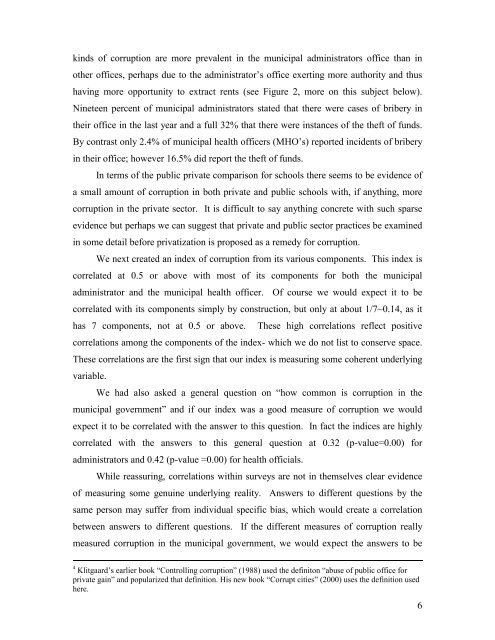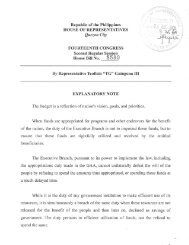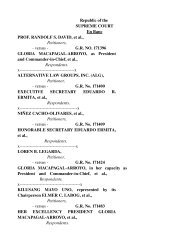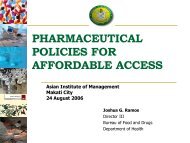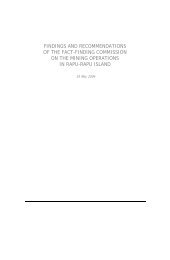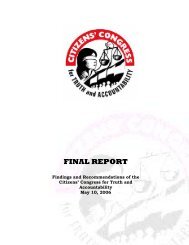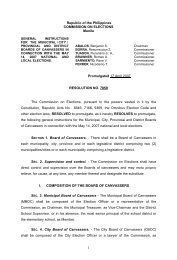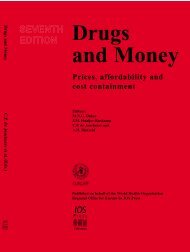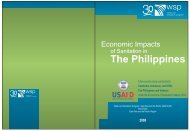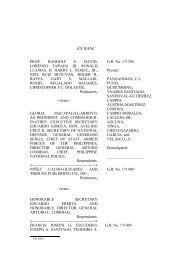Decentralization and Corruption in the Philippines
Decentralization and Corruption in the Philippines
Decentralization and Corruption in the Philippines
Create successful ePaper yourself
Turn your PDF publications into a flip-book with our unique Google optimized e-Paper software.
k<strong>in</strong>ds of corruption are more prevalent <strong>in</strong> <strong>the</strong> municipal adm<strong>in</strong>istrators office than <strong>in</strong><br />
o<strong>the</strong>r offices, perhaps due to <strong>the</strong> adm<strong>in</strong>istrator’s office exert<strong>in</strong>g more authority <strong>and</strong> thus<br />
hav<strong>in</strong>g more opportunity to extract rents (see Figure 2, more on this subject below).<br />
N<strong>in</strong>eteen percent of municipal adm<strong>in</strong>istrators stated that <strong>the</strong>re were cases of bribery <strong>in</strong><br />
<strong>the</strong>ir office <strong>in</strong> <strong>the</strong> last year <strong>and</strong> a full 32% that <strong>the</strong>re were <strong>in</strong>stances of <strong>the</strong> <strong>the</strong>ft of funds.<br />
By contrast only 2.4% of municipal health officers (MHO’s) reported <strong>in</strong>cidents of bribery<br />
<strong>in</strong> <strong>the</strong>ir office; however 16.5% did report <strong>the</strong> <strong>the</strong>ft of funds.<br />
In terms of <strong>the</strong> public private comparison for schools <strong>the</strong>re seems to be evidence of<br />
a small amount of corruption <strong>in</strong> both private <strong>and</strong> public schools with, if anyth<strong>in</strong>g, more<br />
corruption <strong>in</strong> <strong>the</strong> private sector. It is difficult to say anyth<strong>in</strong>g concrete with such sparse<br />
evidence but perhaps we can suggest that private <strong>and</strong> public sector practices be exam<strong>in</strong>ed<br />
<strong>in</strong> some detail before privatization is proposed as a remedy for corruption.<br />
We next created an <strong>in</strong>dex of corruption from its various components. This <strong>in</strong>dex is<br />
correlated at 0.5 or above with most of its components for both <strong>the</strong> municipal<br />
adm<strong>in</strong>istrator <strong>and</strong> <strong>the</strong> municipal health officer. Of course we would expect it to be<br />
correlated with its components simply by construction, but only at about 1/7~0.14, as it<br />
has 7 components, not at 0.5 or above. These high correlations reflect positive<br />
correlations among <strong>the</strong> components of <strong>the</strong> <strong>in</strong>dex- which we do not list to conserve space.<br />
These correlations are <strong>the</strong> first sign that our <strong>in</strong>dex is measur<strong>in</strong>g some coherent underly<strong>in</strong>g<br />
variable.<br />
We had also asked a general question on “how common is corruption <strong>in</strong> <strong>the</strong><br />
municipal government” <strong>and</strong> if our <strong>in</strong>dex was a good measure of corruption we would<br />
expect it to be correlated with <strong>the</strong> answer to this question. In fact <strong>the</strong> <strong>in</strong>dices are highly<br />
correlated with <strong>the</strong> answers to this general question at 0.32 (p-value=0.00) for<br />
adm<strong>in</strong>istrators <strong>and</strong> 0.42 (p-value =0.00) for health officials.<br />
While reassur<strong>in</strong>g, correlations with<strong>in</strong> surveys are not <strong>in</strong> <strong>the</strong>mselves clear evidence<br />
of measur<strong>in</strong>g some genu<strong>in</strong>e underly<strong>in</strong>g reality. Answers to different questions by <strong>the</strong><br />
same person may suffer from <strong>in</strong>dividual specific bias, which would create a correlation<br />
between answers to different questions. If <strong>the</strong> different measures of corruption really<br />
measured corruption <strong>in</strong> <strong>the</strong> municipal government, we would expect <strong>the</strong> answers to be<br />
4 Klitgaard’s earlier book “Controll<strong>in</strong>g corruption” (1988) used <strong>the</strong> def<strong>in</strong>iton “abuse of public office for<br />
private ga<strong>in</strong>” <strong>and</strong> popularized that def<strong>in</strong>ition. His new book “Corrupt cities” (2000) uses <strong>the</strong> def<strong>in</strong>ition used<br />
here.<br />
6


